In July, Jacob’s Pillow had the distinct pleasure of inviting Phil Chan back to campus to give public tours of the second iteration of the Fantasy Meets Reality exhibit at the Archives, which he co-curated with Caroline Hamilton. The public can view the exhibit at Blake’s Barn for the rest of the 2024 Festival.
Phil Chan is the co-founder of Final Bow for Yellowface (along with former New York City Ballet Soloist, Georgina Pazcoguin), an organization whose purpose is bringing nuance and humanity to Asian characters in ballets and eliminating yellowface on stage. Continuing to grow since its inception in 2017, Chan and Final Bow for Yellowface expand their work past the confines of the stage and into the studio, where they uplift and create opportunities for Asian creators in choreographic spaces.
The first iteration of the Fantasy Meets Reality exhibit came to fruition in summer 2023 and was called Fantasy Meets Reality: The Far East Tour, 1925-26. This year’s exhibit, Fantasy Meets Reality: Through the Eyes of a Denishawn Dancer, builds upon 2023’s with newly discovered artifacts from the personal effects of three Denishawn dancers – all young women and all traveling to Asia for the first time.
Both the 2023 and 2024 exhibits cause audiences and observers to take pause and sit with discomfort; prompting questions such as “How do we share culture with integrity?”
The impetus for the Fantasy Meets Reality exhibit came from Chan’s conversations with Jacob’s Pillow about the Pillow’s history. Ted Shawn and Ruth St. Denis’s Denishawn Company achieved great success for their portrayal of the exotic, oriental fantasy in dance.
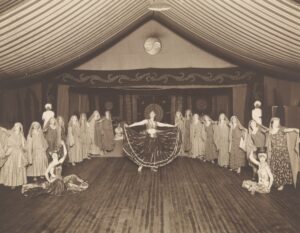
“Norton invited me, along with Dr. Caroline Hamiton, to take a look at this Far East Tour in 1925, where it really looked like a major turning point for the Denishawn company. Where fantasy dances met actual Asian people and culture. How did that change their approach? How did going to Asia change their orientalist repertory? How did their work afterwards change? And what was happening with audience tastes?”
The Denishawn company had been performing its wildly popular orientalist works since before their trip “far east,” as it was referred to by the company. Upon their return, they performed works more true to the Asian cultures that they had experienced while abroad. Unfortunately these performances were unpopular among western audiences and so Denishawn continued to perform their former orientalist works. The money acquired from the success of these orientalist pieces bought the farm that became home to Ted Shawn and His Men Dancers in 1930 and would eventually become the Jacob’s Pillow Dance Festival.
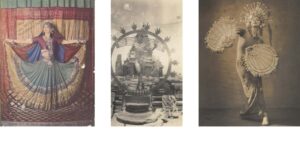
“What [is] Jacob’s Pillow doing as an institution to support Asian artists? Could this be a place for incubating Asian talent? Not just orientalist? Defining those two [things]. One is a European fantasy, the other is an actual Asian culture.”
This prompted discussion about the Archives, particularly the archival objects used in the orientalist repertory Ted Shawn and Ruth St. Denis came to be recognized and admired for. When encountering these objects, there comes a fork in the road – leave the objects as is, remove them entirely, or contextualize those objects and use them as springboards to current contemporary struggles.
“There was some controversy around the paintings [of Ted Shawn and Ruth St. Denis] a couple of years ago. And yes, there’s now a panel writing about it. But beyond that, what is the engagement around this legacy?”
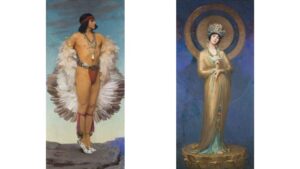
“This is a beautiful painting first of all, just in terms of composition. At the same time, [the painting] is uncomfortable for me as a Chinese person. Kuan Yin is my patron saint and so to see somebody masquerading, it does have a ‘my culture is not your costume’ kind of feeling to it.”
These famous paintings, which once hung on either side of the stage in the Ted Shawn Theatre, became the impetus for a deeper dive into the root of Asian and Asian American dances in the west, the legacy of orientalist dance at the Pillow, and nuanced discussion of how we can presently be in conversation with dances past.
“Ironically, despite the clear cultural appropriation by Ruth St. Denis, there was also an incredibly positive cultural thing that came out of this, which was legitimizing Asian culture as something worthy to see on stage… you couldn’t just say ‘It’s cultural appropriation and it’s bad.’ There was a need for a little more nuance in that discussion.”
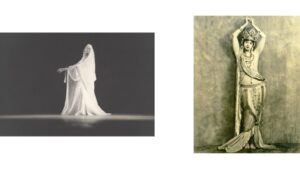
The Fantasy Meets Reality: Far East Tour exhibition holds up a mirror prompting us to reflect on how we share culture and stories in a way that allows us to see one another with more empathy and nuance.
In striving for more nuanced discussion and understanding of Asian-ness on stage, Phil Chan has defined the differentiation between character and caricature to be of paramount importance – “A character has nuance, it has depth, it’s three-dimensional. You build empathy with a character in a way that you don’t with a caricature.”
And just like the nuance in Ruth St. Denis’s appropriation of Asian dance and figures, the conversation of character versus caricature requires a deeper dive. Caricature serves as an effective means of critiquing those in power, making it a significant tool in artistic expression. The critical aspect lies in its application—identifying the target and the direction of the critique – is it grounded in facts, misinformation, ignorance, or malice?
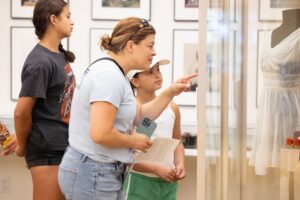
From this discussion, two questions emerged: Where is space being held for Asian artists to share their art? And what constitutes Asian art?
“That’s the question, right? [If] there’s no fans, there’s no dragons, does that still make it Asian? When you work within your ethnic heritage, you’re labeled as an ethnic choreographer.
[There is an] expectation that we, as Asians, are supposed to serve something oriental. The first act [of my production Madama Butterfly] is this glittering, oriental fantasy set in San Francisco ChinaTown. The second half takes place in a Japanese incarceration camp. It’s like a Trojan horse. You think you’re getting oriental, but I’m serving you Asian American.”
Like Chan’s production of Madama Butterfly, conversations about orientalism, appropriation, and representation are evocative and necessary. Revisiting the past through a modern lens, sitting with our discomfort, is the way in which we see the multiple facets and overlapping legacies often contained in fantastical music, dance, and objects.
“We might see the same object, but have two completely different assumptions. That’s a part of this work, too. Being able to look at these objects and say [there are] multiple perspectives to what exactly you’re looking at.
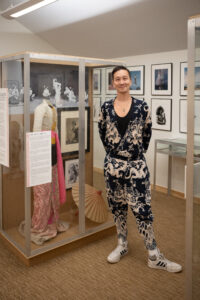
Discomfort can give us the contours of what our emotional boundaries are… The more you sit with it, the more you understand what the dynamic is that makes you uncomfortable.”
“All of these artifacts are both beautiful and discomforting. We are not conditioned to be able to put those two feelings together, and so that’s sort of what the point of this show is. It’s to sit with that discomfort and [ponder] ‘Why is that uncomfortable? And if it’s not, why should it be? And if it is comfortable, how could it not be?”
Visit this exhibit in the Jacob’s Pillow Archive during the 2024 Festival.
This Pillow Pick was written by KC Lin and published on August 3, 2024.